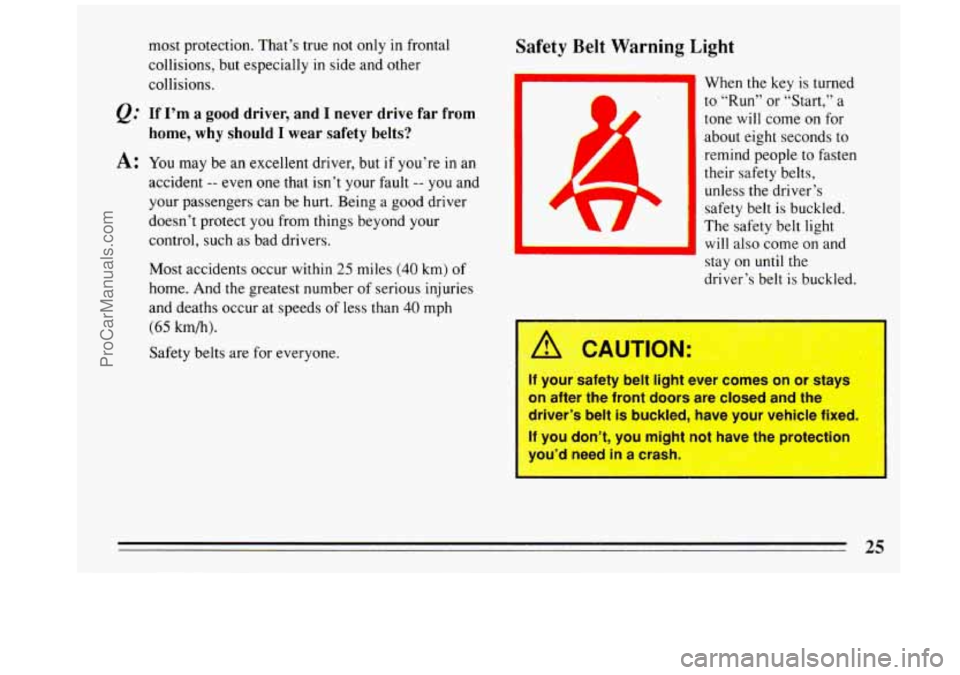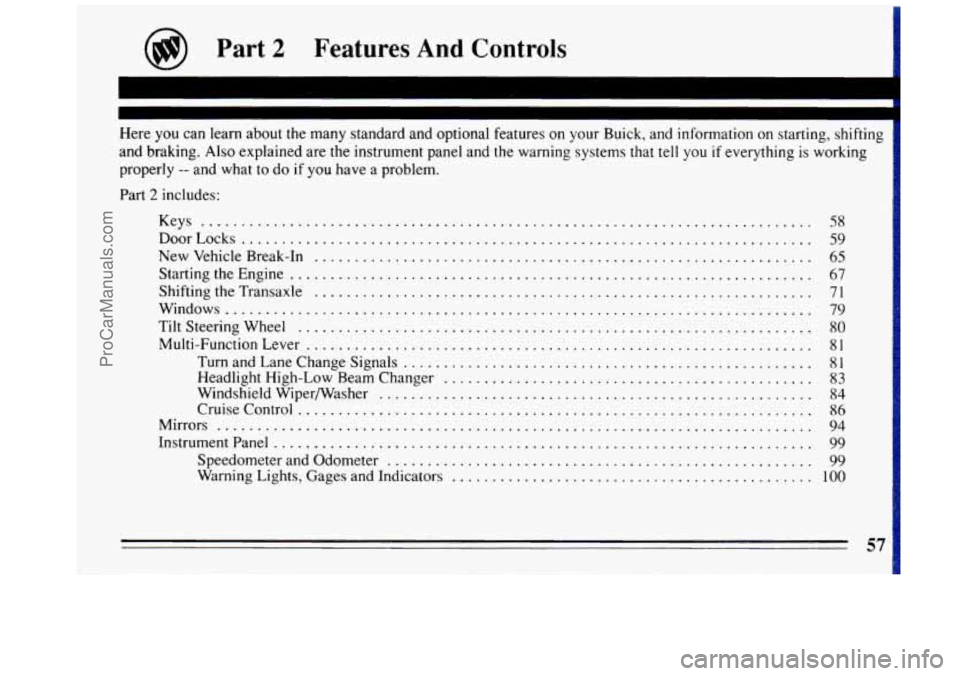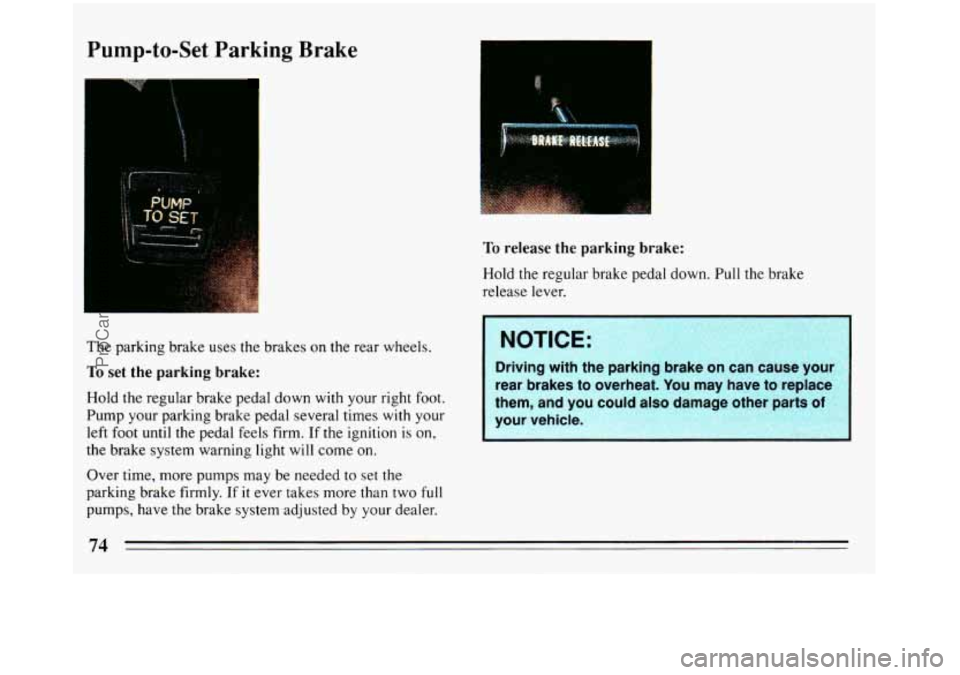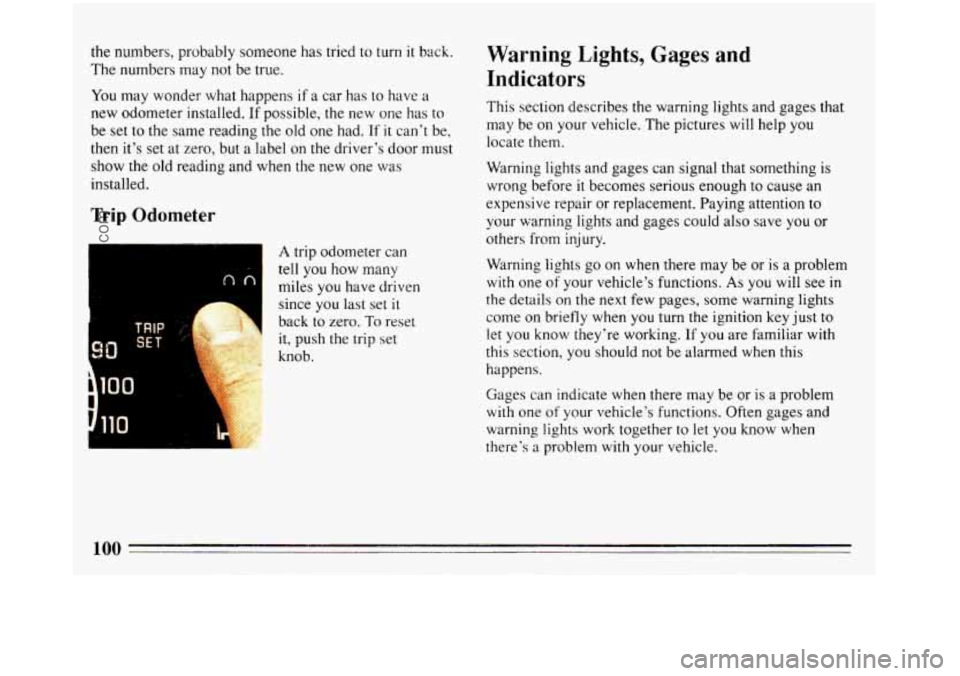1993 BUICK REGAL warning light
[x] Cancel search: warning lightPage 14 of 308

Vehicle Symbols
These are some of the symbols you will find on your vehicle.
For example,
these symbols
are used on an
original battery:
POSSIBLE A
CAUTION
INJURY
PROTECT EYES BY
SHIELDING
CAUSTIC
BURNS AVOID
SPARKS
OR
FLAMES
SPARK
OR ,\I/,
COULD FLAME
EXPLODE BATTERY
These symbols
are important
for you and
your passengers
whenever your
vehicle
is
driven:
DOOR LOCK
UNLOCK
e
e
BELTS 4
POWER
WINDOW
These symbols
have
to do with
your lights:
SIGNALS e @
TURN
HIGH BEAM
OR = =o
FOG LAMPS $0
These symbols
are on some
of
your controls:
WINDSHIELD ' ' ' 0- 0-
WASHER
WINDSHIELD WASHER
WINDOW
DEFOGGER
VENTILATING FAN
HEADLAMP
-
WIPER
WASHER
Q
These symbols
are
used on
warning and
indicator lights:
COOLANT F-
TEMP --
ENGINE
CHARGING
I-1
BATTERY SYSTEM
BRAKE
(0)
RADIATOR 0
COOLANT
FUEL
ENGINE OIL w,
PRESSURE
TEMP
OIL &b
ANTILOCK (a)
BRAKE
Here are some
other symbols
you may see:
FUSE
RADIO
VOLUME
CONDITIONING
AIR 43
HATCHBACK TRUNK
RELEASE
t LIGHTER
HORN
SPEAKER
12
ProCarManuals.com
Page 27 of 308

most protection. That’s true not only in frontal
collisions, but especially in side and other
collisions.
Q.’ If I’m a good driver, and I never drive far from
home, why should
I wear safety belts?
A: You may be an excellent driver, but if you’re in an
accident -- even one that isn’t your fault -- you and
your passengers can be hurt. Being a good driver
doesn’t protect you from things beyond your
control, such as bad drivers.
Most accidents occur within
25 miles (40 km) of
home. And the greatest number of serious injuries
and deaths occur at speeds of less than
40 mph
(65 km/h).
Safety belts are for everyone.
Safety Belt Warning Eight
L J When the key is turned
to “Run” or “Start,” a
tone will come
on for
about eight seconds to
remind people
to fasten
their safety belts, unless the driver’s
safety belt
is buckled.
The safety belt light
I I will also come on and
stay on
until the
driver’s belt is buckled.
I
A CAUTION:
If your safety belt light ever comes on or stays
on after the front doors are closed and the
driver’s belt
is buckled, have your vehicle fixed.
I If you don’t, you might not have the Drotection
you’d need in a crash.
I I
25
ProCarManuals.com
Page 59 of 308

'art 2 Features And Controls
Here you can learn about the many standard and optional features on your Buick. and information on .. starting. shifting ..
and braking . Also explained are the instrument panel and
properly
.. and what to do if you have a problem .
Part 2 includes: the warning
systems that tell you
if every
Thing is working
Keys ........................................................................\
....
DoorLocks ....................................................................... \
NewVehicleBreak-In ..............................................................
StartingtheEngine .................................................................
ShiftingtheTransaxle ..............................................................
Windows ........................................................................\
.
TiltSteeringWheel ................................................................
Multi-FunctionLever ...............................................................
TurnandI, aneChangeSignals ...................................................
Headlight High-Low Beam Changer ..............................................
WindshieldWiper/Washer ......................................................
Cruisecontrol ................................................................
Mirrors ........................................................................\
..
Instrumentpanel ...................................................................
Speedometer and Odometer .....................................................
Warning Lights, Gages and Indicators .............................................
58
59
65
67
71
79
80
81
81
83
84
86
94
99
99
100
ProCarManuals.com
Page 76 of 308

Pump-to-Set Parking Brake
The parking brake uses the brakes on the rear wheels.
To set the parking brake:
Hold the regular brake pedal down with your right foot.
Pump your parking brake pedal several times with your
left foot until the pedal feels firm. If the ignition is on,
the brake system warning light will come on.
Over time, more pumps may be needed to set the
parking brake firmly.
If it ever takes more than two full
pumps, have the brake system adjusted by your dealer.
To release the parking brake:
Hold the regular brake pedal down. Pull the brake
release lever.
.
NOTIC% I
Driving with the parking brake on can cause your
rear brakes to overheat. You may have to replace
your vehicle. them, and
you could also damage
74
ProCarManuals.com
Page 94 of 308

Headlight “On” Warning
If the light switch is left on you’ll hear a warning tone
when you turn the ignition
off and open the driver’s
door.
Fog Eights (GS Only Option)
If you have the fog light
feature, the control is on the
instrument. The parking
lights must be on, for the
fog lights to work. The fog
lights will turn off
when
you switch to high beam
headlights. When you
switch back to
low beam
headlights they
will turn
back on.
Daytime Running Lights (Canada Only)
The Canadian Federal Government has decided that
“Daytime Running Lights”
(DRL) are a useful feature,
in that DRL can make your vehicle more visible to
pedestrians and other drivers during daylight hours.
DRL are required on new vehicles sold
in Canada.
Your DRL work
with a light sensor on top of the
instrument panel. Don’t cover
it up.
The low beam headlights will come on at reduced
brightness
in daylight when:
0 The ignition is on
The headlight switch is off, and
The parking brake is released.
At dusk, the exterior lights will come on automatically
and the low beams will change to.full brightness.
At
dawn, the exterior lights will go out and the low beams
will change to the reduced brightness of DRL (if the
headlight switch
is off>. Of course, you may still turn on
the headlights any time you need to. To idle your vehicle
with the DRL off. set the parking brake while the
ignition
is in the “Off“ or “l,ock” position. Then start
the vehicle. The DRL
will stay off until you release the
parking brake.
92
ProCarManuals.com
Page 102 of 308

the numbers, probably someone has tried to turn it back.
The numbers may not be true.
You may wonder what happens if a car has to have a
new odometer installed. If possible, the new one has to
be set to the same reading the old one had. If it can’t be,
then it’s set at zero, but
a label on the driver’s door must
show the old reading and when the new one was
installed.
Trip Odometer
TRIP
SET 90
A trip odometer can
tell
you how many
miles you have driven
since you last set
it
back to zero. To reset
it, push the trip set
knob.
Warning Lights, Gages and
Indicators
This section describes the warning lights and gages that
may be on your vehicle. The pictures will help you
locate them.
Wdrning lights and gages can signal that something
is
wrong before it becomes serious enough to cause an
expensive re,pair or replacement. Paying attention to
your warning lights and gages could also save you or
others from injury.
Warning lights go on when there may be or
is a problem
with one of your vehicle’s functions. As you will see in
the details on the next few pages, some warning lights
come on briefly when you turn
the ignition key just to
let you know they’re working.
If you are familiar with
this section, you should not be alarmed when this
happens.
Gages
can indicate when there may be or is a problem
with one of your vehicle’s functions. Often gages and
warning lights work together
to let you know when
there’s a problem with your vehicle.
100
ProCarManuals.com
Page 103 of 308

When one of the warning lights comes on and stays on
when you are driving,
or when one of the gages shows
there may be a problem, check the section that tells
you
what to do about it. Please follow the manual’s advice.
Waiting to do repairs can be costly
-- and even
dangerous.
So please get to know your warning lights
and gages. They’re a big help.
Fuel Gage
UNLEADEL,
FUEL
ONLY
Your fuel gage shows about
how much
fuel is in your
tank. It works
only when
the engine is on. When the
indicator nears
“E,” you
still have a little fuel left.
You need to get more right
away.
Here are
four concerns some owners have had about the
fuel gage. All these situations are normal and indicate
nothing wrong with the
fuel gage.
8 At the gas station, the gas pump shuts off before the
gage reads
“F”.
indicated. For example, the gage indicated 1/2 full,
but
it took more -- or less -- than half of the tank’s
capacity
to fill it.
e It takes more (or less) gas to fill up than the gage
e The gage moves a little when you turn a corner,
speed
up, or stop your vehicle.
When
you turn the engine off, the gage doesn’t go all
the
way back to “E”.
Low Fuel Light
LOW
FUEL
When your fuel gage reads
in the red band, this light
will
go on. You should get
more fuel as soon
as you
can.
101
ProCarManuals.com
Page 104 of 308

Brake System Warning Light
(a)(!)
BRAKE
Your Buick’s hydraulic
brake system is divided into
two parts. If one part isn’t
working, the other part can
still work and stop you. For
good braking, though, you
need both parts working well.
If the warning light goes on, there could be a brake
problem. Have your brake system inspected right away.
This light should come on as you start the vehicle.
If it
doesn’t come on then, have it fixed
so it will be ready to
warn you if there’s a problem. This
light will also come on when you set your parking
brake, and will stay on if your parking brake doesn’t
release fully. If it stays
on after your parking brake is
fully released, it means you have a brake problem. If the
light comes on while driving, pull off the road and stop
carefully. You may notice that the pedal is harder
to
push. Or, the pedal may go closer to the floor. It may
take longer to stop.
If the light is still on, have the
vehicle towed for service. (See “Towing Your Vehicle”
in the Index.)
A CAUTION:
Your brake system may not be working properly
if the brake warning light is on. Driving with the
brake warning light on can lead to an accident.
If
the light is still on after you’ve pulled off the road
and stopped carefully, have the vehicle towed fo
service.
aw,Tp 1 e- c -
102
ProCarManuals.com